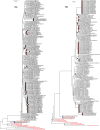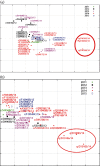Novel reassortant H9N2 viruses in pigeons and evidence for antigenic diversity of H9N2 viruses isolated from quails in Egypt
- PMID: 27902350
- PMCID: PMC5817215
- DOI: 10.1099/jgv.0.000657
Novel reassortant H9N2 viruses in pigeons and evidence for antigenic diversity of H9N2 viruses isolated from quails in Egypt
Abstract
The endemicity of avian influenza viruses (AIVs) among Egyptian poultry represents a public health risk. Co-circulation of low pathogenic AIV H9N2 subtype with highly pathogenic AIV H5N1 subtype in Egyptian farms provides a possibility to generate novel reassortant viruses. Here, the genetic characteristics of surface glycoproteins of 59 Egyptian H9N2 viruses, isolated between 2013 and 2015, were analysed. To elucidate the potential of genetic reassortment, 10 H9N2 isolates were selected based on different avian hosts (chickens, ducks, pigeons and quails) and phylogenetic analyses of their full genome sequences were conducted. Additionally, we performed antigenic analysis to further investigate the antigenic evolution of H9N2 viruses isolated during 2011-2015. Different viral characteristics including receptor-binding affinity and drug resistance of representative Egyptian H9N2 viruses were further investigated. The surface glycoproteins of current Egyptian H9N2 viruses were closely related to viruses of the G1-like lineage isolated from Egypt. Several genetic markers that enhance virulence in poultry and transmission to humans were detected. Analysis of the full genome of 10 H9N2 isolates indicated that two pigeon isolates inherited five internal genes from Eurasian AIVs circulating in wild birds. Antigenic conservation of different Egyptian H9N2 isolates from chickens, pigeons and ducks was observed, whereas quail isolates showed antigenic drift. The Egyptian H9N2 viruses preferentially bound to the human-like receptor rather than to the avian-like receptor. Our results suggest that the endemic H9N2 viruses in Egypt contain elements that may favour avian-to-human transmission and thus represent a public health risk.
Conflict of interest statement
The authors declare that there are no conflicts of interest.
Figures







References
-
- Guo YJ, Wen LY, Zhang Y, Wan M, Guo JF, et al. [Do pigs play a role in human infection with avian influenza A H9N2 viruses?] Zhonghua Shi Yan He Lin Chuang Bing Du Xue Za Zhi. 2005;19:106–109. (English abstract) - PubMed
MeSH terms
Grants and funding
LinkOut - more resources
Full Text Sources
Other Literature Sources
Medical

